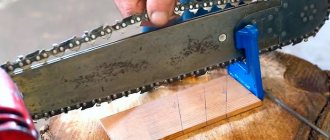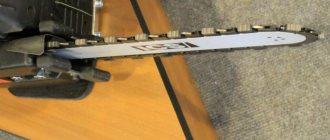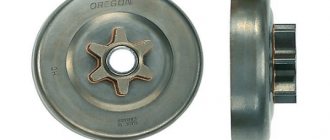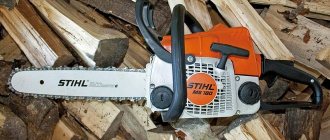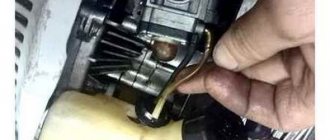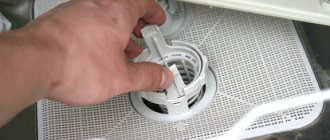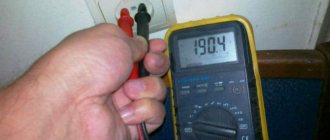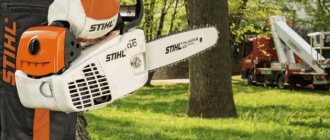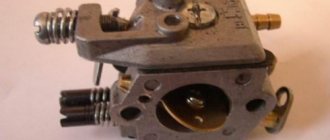No. 1. Chainsaw won't start
If you're having trouble starting your chainsaw, many people immediately turn to the carburetor. In fact, there are several options, and the cause of the problem could be any:
- Air and/or fuel filters are clogged. The problem can be solved by cleaning the filters.
- Lack of fuel in the tank. Yes, there is a reason. Some owners forget about such an insignificant detail as refueling a chainsaw, and think that a couple of liters of gasoline will last for six months. In addition, fuel should not be stored in the tank for more than 14 days, as gasoline evaporates and octane is lost.
- Check the line from the fuel tank to the carburetor. It may become clogged or broken to prevent gasoline from entering the tank.
- There is no spark at the spark plug. Why is there no spark? There can be many reasons: there is no contact, the spark plug needs to be changed, or it is flooded. Why pour a candle on a chainsaw is another question. But if this happens, it needs to be dried and reinstalled, and then checked for sparks. If the spark plug has severe carbon deposits, it is recommended to replace it.
- Check the muffler for carbon deposits. If there is soot, thoroughly clean the muffler, but it is still recommended to take the chainsaw to a service center so that they can check the cylinder and piston, since soot is a sure sign of a malfunction of the elements of the cylinder-piston group.
- The carburetor is clogged. How to properly adjust a chainsaw so that the carburetor works well is discussed in a separate article.
If none of the above methods help, the reason is more serious. Malfunction of one of the components of the connecting rod and piston group. In this case, it is recommended to take the chainsaw to a service center.
Basic malfunctions and ways to eliminate them
When starting to repair a chainsaw, you need to have an idea of what malfunctions it may have, as well as how these malfunctions are eliminated. So, let's look at the signs of malfunctions and how to fix them.
Husqvarna chainsaw does not start
If the Husqvarna does not start, the first thing you need to make sure is that you follow the algorithm for starting the saw, as well as the presence of fuel in the tank. Detailed instructions on how to start a cold chainsaw and refuel it are available in the saw manual that comes with all Husqvarna chainsaws.
If you do everything correctly, but the saw does not respond, the reason may be a malfunction of the ignition system or lack of fuel supply.
To more accurately determine the reasons for this behavior of the chainsaw, it is necessary to inspect the spark plug, and then check it for the presence of a spark.
If the spark plug is wet and no spark is detected when checking, you should try replacing the spark plug itself. The replacement did not produce results, which means the problem may be hidden in the ignition coil, which is quite difficult to check on your own.
If there is a spark, but the spark plug is dry, there is a problem in the fuel system. To eliminate it, you need to carry out a full diagnosis. The fuel system consists of a carburetor and a fuel line. Without any specific experience, you can check the fuel line for ruptures, as well as the cleanliness of the fuel filter installed in the tank. It is better to entrust complete carburetor diagnostics and repairs to professionals.
If the saw starts, but poorly
The cause of difficulty starting the saw may be a malfunction or incorrect adjustment of the carburetor. If the carburetor overflows, the chainsaw will be easy to start when hot, but quite difficult when cold, especially after a long period of inactivity.
An indirect sign of an excessive amount of fuel mixture entering the cylinder when the chainsaw is operating is the exhaust. If a lot of white smoke is emitted when the chainsaw is running, it is worth checking the proportions of the fuel mixture and carburetor adjustments.
Chainsaw chain spins at idle speed
If the Husqvarna chain rotates at idle, then we can conclude that there is a malfunction in the clutch mechanism or the idle speed is not adjusted. To eliminate the malfunction, it is necessary to remove the saw chain brake cover and inspect the integrity of the clutch spring. Replace defective clutch.
If the clutch is working properly, to eliminate chain spinning, it is necessary to adjust the idle speed using the adjusting screw marked with the letter (T) or carry out a full carburetor adjustment.
Important: a possible reason for an independent increase in idle speed is the appearance of air leaks into the engine crankcase or carburetor, which can lead to serious damage to the CPG
Why does the Husqvarna chainsaw stall when you press the gas?
If the saw stalls immediately after pressing the gas, it is necessary to inspect the spark plug, which will help more accurately diagnose the problem. A wet spark plug indicates a malfunction or incorrect adjustment of the carburetor; in this case, the situation can be corrected by carrying out a complete diagnosis, repair and adjustment of this unit. If repairs and adjustments do not help, you need to replace the carburetor with a new one.
Another reason why a Husqvarna may stall when you press the gas is a malfunction in the fuel system, or more precisely, difficulty in supplying fuel to the carburetor. It is necessary to check the cleanliness of the fuel filter, as well as the integrity of the fuel hoses.
Why is the chain on the Husqvarna chainsaw not lubricated?
If your chainsaw has completely stopped supplying saw chain lubrication, then you need to check the entire oil system.
There may be several reasons:
- Oil pump malfunction;
- Clogged filter element installed in the tank;
- Oil tank breather malfunction;
- Oil hose rupture;
- Mismatches in the oil hole on the bar and on the saw body (if the supply stopped after installing a new saw bar);
- Clogged oil channel in the saw body;
- Clogged oil supply channel in the tire;
- Oil pump drive gear malfunction.
No. 2. The engine stalls
The engine started, but only at idle or when loading stalls with a chainsaw. In this case, you should often follow the same steps as described above.
How to properly adjust a chainsaw depends on when the problems start:
Stalls immediately after starting:
- The fuel mixture is not prepared properly, there is too much oil in it, so the octane number of gasoline is less than it should be, so the chainsaw only works on suction or settles immediately.
- A blow to the spark plug or incorrect gap between the spark plug and wire.
READ Husqvarna 137 Chainsaw Lubricant
It stalls and does not work at idle:
- The muffler is clogged. The deposit must be cleared.
- Carbon settings have been lost. The idle speed on the chainsaw needs to be adjusted. This is done using adjusting bolts marked L and H. For how to adjust idle speed, see the article on carburetor adjustment.
Stalls at maximum speed and only runs on choke
- The air or fuel filter is clogged. The seals need to be cleaned and checked.
- The fan is clogged, and because of this, fuel does not flow, and pumping gasoline to the chainsaw does not work. Take the needle and clean the breather thoroughly.
- Fuel pump malfunction. Remove the pump and check for gasoline leaks. If there is a leak, replace the gasket or the pump itself.
The chainsaw does not cut under load and stalls
- The air filter is clogged. You'll need to remove the filter, clean it, or even wash it, dry it, and reinstall it.
- Incorrect proportion of mixture of oil and gasoline. Drain the fuel and mix the oil and gasoline again in the correct proportions.
We deal with typical chainsaw chain breakdowns
Why does the chain fall off?
Why does it break, or why does it get jammed when working with a chainsaw for a long time? There may be several reasons why the chain breaks, but the most common of them is mechanical damage to the bar on which the saw element of the tool is held.
Why does the chain on a chainsaw jam?
The reason for this also lies in the deformation of the tire. If it was compressed as a result of an impact, then, accordingly, the chain teeth will be locked inside the tire groove. Another reason why the chain does not spin is a broken adjusting bolt, which is used when installing a new saw element. To accurately understand why the chain does not rotate, you need to dismantle the bar and carefully inspect the internal structure of the chainsaw for debris inside it. You will also need to inspect the tool's air filter for blockages.
If the chain does not stop at idle
In this case, you will need to check the integrity of the screws holding the tire. It is quite possible that as a result of wear or impact, the threads on them have become unusable.
The chainsaw does not cut under load
If it also makes strange sounds, then most likely the chain tension screws have become deformed. To repair, faulty parts must be replaced immediately.
Why does the chain stretch?
Most often it is the poor quality of the saw element itself. If you notice signs of stretching, the part should be replaced immediately.
DIY chainsaw repair and service
Prices for chainsaws are falling and this makes them more popular and accessible not only to experts, but also to ordinary, so to speak, amateurs. But the widespread dependence - the lower the cost, the less reliable the device and the more often malfunctions occur, is also vital for a chainsaw. But for a chainsaw of any price range, most defects can be avoided with proper operation, care and timely maintenance of the equipment. But no one is insured against the breakdown of a chainsaw, as well as any other equipment. Therefore, it is proposed to consider the main types of chainsaw malfunctions, methods for diagnosing, eliminating and repairing them.
.
All the main malfunctions of chainsaws can be divided into two main categories: - malfunctions of the engine and its various components: fuel preparation and supply system, ignition, piston group with crankshaft, exhaust gas exhaust system; — malfunctions and breakdowns of other components: lubrication system, clutch, chain brake, tire and others.
No. 3. The engine "shoots"
If during operation there are extraneous sounds similar to gunshots, there is a problem with the muffler or carburetor. How to make a chainsaw work quietly? It depends on which node is faulty.
Shoots the carburetor:
- Ignition is too late. The fuel-air mixture does not have time to burn in the cylinder, so it makes a sound similar to a small explosion.
- Poor air-fuel mixture. Too little gas enters the mixture. To increase the fuel supply, you need to adjust the chainsaw, or rather the jets. Why does the chainsaw blow by itself? For the same reason.
Shoots at the silencer:
- Enriched air-fuel mixture. Why does a chainsaw “shoot”? The mixture contains too much gasoline and not enough air, so the mixture does not burn out completely in the chamber and partially burns out in the muffler. Exhaust soot. A clear sign of this. The air filter needs to be cleaned or the carburetor adjusted.
The chainsaw is getting hot, what is the reason?
Content
For what reasons does a chainsaw start and not stall?
The introduction of a chainsaw simplifies difficult work. But when the chainsaw starts, it doesn’t stall, the reason
This is for you at least. What to do? You need to choose: take it to the workshop to specialists, as they also call it, and try to repair it with your employees. We will try to help the reader understand the reasons for the failure, methods for eliminating breakdowns, and we will not give advice on operating chainsaws. Next, it is useful for the owner to find out what remains to be done by our client about the factory instruction manual and the design features of his own chainsaw. This information will help him to use it well and repair the instrument skillfully.
Circuit diagram of a chainsaw.
Characteristics of the internal combustion engine of chainsaws
The main malfunctions of chainsaws are associated with engine failures. To drive the chain, Russian and foreign Russian manufacturers use single-cylinder two-stroke internal combustion engines. The design of the motor is ordinary. Ignition is ordinary, without installing capricious electronics. Chainsaw engines work well in different climate conditions. Fuel for a carburetor engine is obtained by mixing AI-92 gasoline and special oil. Because the design does not include an oil pump, the piston and cylinder are lubricated with a mixture of gasoline and oil. The saw engine develops power from two to 5 kW, and the crankshaft speed reaches fourteen thousand rpm. At such high speeds and loads, the requirements for oil are special. Use the oil indicated in the instructions. When changing the oil to regular motor oil, the tool's service life is sharply reduced. Remember that filling the tank with gasoline without adding oil is strictly prohibited.
Tools and materials
Diagram of a two-stroke chainsaw engine.
The design of mechanical components of chainsaws is characterized by good reliability and maintainability. Almost all units and parts have free access. If the necessary equipment is available, they can be easily removed for repair or replacement. To disassemble and check the life support systems of a chainsaw engine, you should stock up on the following tools and materials:
- a set of plumbing and assembly tools;
- socket wrench;
- tester;
- pressure gauge for measuring compression;
- probes for measuring gaps;
- needle;
- sandpaper;
- fuel mixture (gasoline oil);
- rags.
READ What Should Be the Spark on a Chainsaw?
Classification of engine faults
Before starting the chainsaw, it is necessary to check the condition of the saw part and fill the fuel and oil tanks. After checking, proceed to launch. If deviations or malfunctions in the drive operation occur, it is necessary to carefully inspect the saw motor. As a result of an external inspection, make sure that all components are complete and intact, that there are no mechanical damages, or any gasoline or oil leaks. Let us point out the main malfunctions associated with poor engine performance:
Chainsaw fuel system.
- The engine does not start.
- It starts, but soon the chainsaw stalls.
- It works unstable.
- Stops functioning under load.
- Loses its power.
Eliminating overheating on a chainsaw
For the sake of experimentation, tests are still to be continued.
Engine troubleshooting is carried out in the following main directions:
- failure of the ignition system;
- failures in the fuel supply system;
- piston group malfunction.
Saw mechanisms require constant care, preventative maintenance and repairs.
Knowledge of the operating principle of a two-stroke gasoline engine will help the operator independently determine the cause of the failure and quickly restore the operation of the chainsaw.
Troubleshooting yourself
If it is impossible to start the engine, it is necessary, observing the order, to perform the following actions:
Location of the air filter and spark plug.
- Check the presence of gasoline in the tank.
- Replace fuel if it has been stored for more than a month.
- Check the fuel filter. Disconnect the hose from the carburetor and observe the stream that flows out. If gasoline flows freely, the fuel filter is not clogged. If the flow rate is insufficient, clean the hole in the tank cap or filter.
- Clean the air filter . The air filter
can be removed for a test run - Inspect and clean the muffler from burning.
- Check the functionality of the launcher. If necessary, repair the starter (replace the pulley, spring or cable).
- Disassemble and clean the clogged carburetor.
- Test the high-voltage wire with a tester to ensure there is no break.
- Measure the gap between the flywheel magnets and the ignition module (should be 0.2 mm).
- Unscrew the spark plug and inspect it. Measure the gap between the electrodes with a feeler gauge (normally 0.5-0.6 mm). Based on the appearance of the electrodes, we determine the nature of the malfunction. If the spark plug is dry, there is no supply of working mixture. A working part flooded with gasoline indicates poor carburetor adjustment or lack of spark. To check for spark, connect the high voltage tip to the spark plug, place the skirt on the cylinder radiator and pull the starter cord. If there is no discharge between the electrodes, the spark plug must be replaced. The formation of carbon deposits on the electrodes indicates a poor quality of the fuel mixture. The central and side electrodes should be cleaned with sandpaper.
- No compression. The reason is failure of the piston group . Measure compression. First you need to unscrew the spark plug. Then insert the pressure gauge into the cylinder bore and use the starter cord to move the piston. piston group
(CPG) is judged by the pressure in the cylinder It must be at least eight atm. Low performance is caused by wear of the cylinder, piston, and piston rings.
READ DIY Handheld Circular Saw Attachments
What should I do if the engine stalls after starting?
Diagram of the interaction of fuel and air flow in a chainsaw carburetor.
We often observe that the saw does not operate for long after starting - the chainsaw stalls almost immediately. This malfunction has characteristic symptoms. The list shows the probable causes of the malfunction and how to eliminate it:
- Lack or low volume of fuel. If a failure occurs when sawing in an inclined position, this indicates that the intake tube is rising above the fuel level. Check for fuel in the tank. Fill with gasoline to the required level.
- Poor quality fuel mixture. Prepare fuel in strict accordance with the saw manufacturer's instructions. Replace the mixture completely.
- The breather is clogged. Low fuel consumption to the engine. Breather is a breathing hole in the tank cap. Clear the clog with a needle.
- Poor contact of the spark plug with the high-voltage wire cap. In this case, the porcelain insulator of the candle gets very hot. Clean the contact and fit the cradle tightly onto the spark plug.
- Spark plug faulty. Replace with a new one or a known good one.
- The muffler is clogged with combustion products (exhaust gas). The muffler needs to be cleaned.
- The carburetor is not adjusted. To adjust the quality of the mixture, the carburetor has three screws: “L”—fine adjustment, “H”—coarse adjustment at high speeds, and “T”—adjustment at idle speed. By observing the sequence of adjusting the screws, we achieve higher crankshaft speeds.
- The air filter is clogged . Air enters the carburetor in small quantities - we get an enriched mixture. The saw stalls as the load increases when cutting hardwood and large diameter trunks. Rinse the filter in warm water and dry.
- Failure of the piston group. Replace defective parts.
READ Carver Chainsaw Won't Start
Now you can independently find and eliminate the reasons why chainsaws start and stall, the reasons why they stop. Recall that the chainsaw
develops high speed of movement of the working body (chain) and is considered a dangerous cutting tool. Strictly follow safety rules when performing work, servicing and repairing the chainsaw.
Source
No. 6. The chainsaw cuts to the side
When cutting, you may notice that the cut is uneven. Why were you drinking crookedly with a chainsaw? There are several reasons:
- Incorrect chain sharpening. The teeth are sharpened at the wrong angle or in only one direction. Proper sharpening is not required.
- Incorrectly selected chain. At very high speeds you can see even a 0.2-0.3mm difference between the groove width or placement width, why chainsaw and side saws. You need to install the appropriate schema.
- Uneven tire wear. Over time, the tire wears on one side and then the chain moves to the side. Rotate the tire regularly so that it fits on both sides. If the wear is excessive, replace the tire.
READ Chainsaw Is Intermittent and Stalls
Why does a chainsaw start and stop immediately?
The chainsaw starts and immediately forgets; the reason for this behavior can be hidden in the carburetor. A faulty fuel pump or malfunction of the main fuel jet can cause this behavior of the saw. The inability to operate the chainsaw after starting requires a full diagnosis at a service center.
READ Fuel consumption of Stihl Ms 180 chainsaws
All of the above options for engine malfunction have similar causes, which, depending on their negligence, can have different manifestations. For example, if a little air is sucked into the crankcase, its operation will not change much, the engine power will decrease slightly, the maximum speed will increase, and it will be able to warm up a little. In the middle stages of an air leak, the engine will stall at idle and become very hot during operation. A severe air leak will make the saw impossible to operate, it will immediately start and stop.
In parallel with visible manifestations of malfunctions, such as the inoperability of the chainsaw after starting, processes will occur inside the engine during its failure that irreversibly lead the saw to the most serious consequences, such as melting of the piston, jamming of the crankshaft.
No. 7. Chain lubrication problems
For proper operation, the chain must be constantly lubricated to reduce friction between the bar and the links, and also to prevent premature wear of the links.
- If the chain is not lubricated on your chainsaw, there is a problem with the oil pump. Oil is not supplied due to a clogged channel. Lack of oil causes the chain to stretch or break. Clean the channels, the smallest particles of wood chips get there and clog them. This can also break the oil hose. If you need to adjust the oil pump chainsaw or repair it, it is better to contact the service department.
- Oil splashes from the chain. Wrong oil selected. It's too thin, so don't lubricate the links as much as splatter on the wood. Replaces fat with thicker fat.
Why is oil leaking?
Many owners of chainsaws are faced with the problem of oil leaking from under the unit. Most often, oil leaks due to damage to the oil hose connected to the oil pump.
The photo below shows exactly the case when the end of the hose has torn and does not fit tightly onto the pump nozzle.
But to get to this place, you will need to remove the clutch mechanism from the shaft. In some models of chainsaws, oil may leak out at the junction of the oil pump with the oil tank hose (indicated by an arrow in the photo).
To eliminate the lubricant leak, you will need to pull this hose out of the seat. To do this, you can use pliers to pull the outer part. You will see a rubber plug
, which is the cause of oil leakage. This plug needs to be wiped well to remove any remaining oil, after which its seat needs to be sealed with something. You can use automotive sealant or fum tape, as shown in the following photo.
1) Malfunction
chainsaws: The chain rotates almost constantly (the engine may not work stably).
Causes of
the malfunction: The clutch spring has burst.
repair
: Replace the broken clutch spring with a new one (for details, see below “How to remove a chainsaw clutch”). Husqvarna chainsaws have one clutch spring and two weights, Shtil chainsaws have three clutch springs and three weights (cams, sectors). If you cannot find the clutch spring itself, you will have to replace the entire clutch.
2) Malfunction
chainsaws: The chain rotates almost constantly, sometimes extraneous sounds are heard in the clutch.
Causes
of the malfunction: The clutch cam chip broke off (due to overheating) and the clutch spring flew off.
Overheating is indicated by blue clutch cams. Overheating to the point of clutch failure can occur if you operate a chainsaw with the chain brake engaged or with a blunt chain. repair
: Replace the clutch assembly (for details, see below “How to remove a chainsaw clutch”).
3) Malfunction
chainsaws: The clutch often “slips”, sometimes the spring bursts.
Causes of
the malfunction: Wear of the chainsaw clutch.
DIY chainsaw repair
No. 8. The chain falls off
Why does the chain fly off the tire? There may be several reasons, and they are all different:
- Worn drive or sprocket. As the sprocket wears, the grip on the chain decreases, causing the chain to fly out of the chainsaw. The sprocket needs to be replaced.
- The chain is tight. Why does a chainsaw chain stretch due to insufficient lubrication? The metal is heated and stretched, albeit by fractions of a millimeter, but given the number of links, even 3-4 mm is enough for the chain to fly off the tire. The scheme must be changed.
- The chain tensioner is loosened by adjusting its tension. How to adjust a chainsaw, or rather the chain tension? You need to adjust the tensioner. This can be done in just a few minutes.
No. 9. The chain does not rotate
Why doesn't my chainsaw chain rotate when the engine is running even at full speed?
- Leading star. Either it is stuck or the crown is so worn that it does not touch and the chain does not turn on the chainsaw. In any case, you need to disassemble the sprocket to find out the exact reason why the chain is not turning. If the crown is worn. It is necessary to replace the sprocket (or the crown itself, if the sprocket has a prefabricated structure).
- The brake chain is stuck. As a result, the sprocket is blocked by the brake mechanism when the engine is running. You need to turn off the engine and release the brakes. If this happens under load, the brake mechanism will have to be replaced like a sprocket, because due to the high temperature, many elements can melt and overheat.
Chainsaw chain problems
In addition to problems with the engine, the chainsaw may experience operational problems due to a malfunction of the cutting (sawing) unit, consisting of an oil pump, bar and saw chain.
There is no oil getting to the tire
Usually, if oil does not flow to the chainsaw chain, you need to check the channels through which oil is supplied to the tire and clean them of dirt. If the previous steps did not reveal the cause of the problem, then you will have to check the oil pump. To do this you need:
- remove part of the chainsaw casing;
- remove the coupling;
- unscrew the 3 screws and remove the cover hiding the pump;
- get to the worm gear gear that rotates the pump shaft.
If the thread on it is worn out, the shaft does not rotate, the pump does not work, and the chain is not lubricated. A worn gear needs to be replaced. You can also remove the oil pump itself and manually try to pump oil through it. If it does not pump, the pump should be replaced.
Chainsaw oil filter
Also, a lack of lubricant may be due to its leakage
. You should check how tightly the pipes coming from the oil pump are connected. If the tightness is broken, the tubes are replaced with new ones.
The chain breaks
If the chain breaks while the chainsaw is running, this could happen when it hits a hard object, such as a nail. If the chain constantly breaks, then the reasons may be the following.
- Low quality metal
from which the saw chain is made. It is necessary to buy gas cutter saws from reputable brands. - Chain overheating due to poor lubrication
. As a result, the saw overheats, the properties of the metal change, and it breaks under load. It is necessary to check the entire chainsaw lubrication system (discussed above).
You can also learn about the reasons for frequent circuit breaks from this video.
The chain doesn't turn
This nuisance often plagues inexperienced chainsaw owners. to remove the brake after starting the engine.
. As a result, the chain does not spin, the brake system overheats, and the clutch mechanism fails. The problem is solved by removing the saw from the brake. If the clutch is not burnt out, you will notice the chain turning. Otherwise, the clutch mechanism will need to be replaced.
The chain gets dull quickly
Basically, the reason that the chain becomes dull quickly is the poor quality of the saw.
. Trying to save money on buying branded chains, chainsaw owners buy saws from unknown manufacturers, or, due to inexperience, purchase counterfeits of well-known brands. It is best to buy a cutting element for a gas cutter in company stores. Stihl saw chains are very popular among owners of this equipment.
The chain doesn't stop
If, when working with a chainsaw, you notice that the saw chain does not stop at the right moment, then this breakdown may have 2 options.
- The brake band is dirty
. When operating the saw, dirt, sawdust, dust, etc. may get under the band. As a result, the brake mechanism becomes blocked and the chain does not stop when the gas is released. The problem is eliminated by cleaning this unit. - The brake band is worn out
. This element of the brake system needs to be replaced.
The chain is jammed
This happens when the drive or driven sprocket wears out.
The chain usually starts to jam under load. But without load the saw can rotate. The photo below shows a worn chainsaw drive sprocket.
The next photo shows that the reason why the chain jams must be looked for at the location of the driven sprocket.
But what to do if the chainsaw is completely jammed?
and all attempts to pull the starter are unsuccessful? This malfunction sometimes occurs on Chinese-made chainsaws. It is caused by the bolts that screw the engine to the plastic casing of the unit becoming loose due to vibration. These bolts are located directly under the flywheel (magneto). In the photo below, arrows show the location of the problem bolts.
As they unscrew, they begin to rub against the flywheel and can completely jam the chainsaw. The following photo shows the flywheel with some scuff marks from the bolts.
To fix the problem, you will need to remove the flywheel from the engine shaft and tighten the bolts.
The chainsaw cuts crookedly
This problem can occur if the chain is dull or improperly sharpened. This applies to a greater extent to new chainsaws. But if the tire wears out
, then even after replacing the chain you will notice that the saw is pulled to the side. Tire wear can be easily determined by placing it on a level table and applying a square to it, as shown in the following photo.
In this case, you can see that there is a gap of about 2 mm between the tire and the corner. It is because of this one-sided tire wear that the chainsaw cuts crookedly. The problem can only be solved by replacing the tire with a new one.
No. 10. Chain brake does not work
All chainsaws are equipped with a main and inertial (emergency) brake. The latter is activated only when hit on the back. The main brake is designed to stop the chain while the engine is running. Why is the chain on the chainsaw jammed and won't stop? There are two options:
- The brake lining is badly worn and does not provide sufficient braking effect. The brake belt needs to be replaced.
- The tape is dirty. During operation, the axillary space may become clogged with debris: shavings, sawdust, dirt, etc. Debris blocks the operation of the brake mechanism, so if the brake does not work, it is necessary to clean the brake mechanism.
Source
Many e-cigarette smokers face such a common problem as the device overheating during operation. An increase in temperature indicates a product malfunction that may lead to permanent failure. Therefore, it is necessary to consider why the lime heats up.
READ Adjusting the Idle Speed of a Stihl Chainsaw
How to properly adjust a chainsaw - tips for beginners
In most service centers, chainsaw adjustment is performed using special equipment. Each model has its own optimal screw rotation angles. As a rule, chainsaws do not require frequent carburetor adjustments. However, they may be required in certain cases:
- If the engine pistons are heavily worn, this is precisely the reason why the chainsaw fires;
- If a blockage forms inside the carburetor as a result of the use of low-quality gasoline and the failure of the air filter, in such cases it will be necessary not only to adjust, but also to flush the unit;
- If the protective cover is damaged, this is often the reason why the chainsaw revs up on its own.
There are a number of signs that directly indicate the need to adjust the carburetor:
- The engine does not idle or the chainsaw does not start at all - the reason lies in a poor fuel mixture;
- Fuel consumption and the volume of exhaust gases have increased sharply - this is a consequence of the carburetor being oversaturated with the fuel mixture.
The carburetor setting diagram may differ for different chainsaw models. But despite this, the general principle remains unchanged.
- L – Stands for “Low”, and is used to adjust low speeds;
- H – Has the value “High”, and is responsible for working at high speeds;
- T (S, LA) – used to adjust idle speed.
Before adjusting the chainsaw, you should make sure that the cutting chain of the tool is directed in the direction opposite to you. The chainsaw must be placed on a flat surface so that its chain does not touch other objects.
Before adjusting the chainsaw, carefully study the procedure specified in the operating instructions. Setting up a chainsaw carburetor consists of two stages - the basic stage, in which the engine is not started, and the final stage, when the chainsaw engine is warmed up and running. The procedure is as follows:
- Slowly tighten screws L and H clockwise until they stop, then turn them one and a half turns counterclockwise;
- Start the engine and leave the chainsaw running at low speed for 10 minutes;
- Next, proceed to the final setup. Before adjusting the idle speed of the chainsaw, you will need to turn the idle speed screw counterclockwise until the engine speed is minimal, the engine runs stably, and the chain stays in place. If the motor stalls in this position of the screw, then the screw must be turned clockwise. If adjusting the idle speed on the chainsaw has resulted in the chain spinning at idle, then the screw needs to be turned slightly counterclockwise;
- Then you need to check the chainsaw for engine acceleration. To do this, gently press the gas lever. If the speed increases slowly, then you need to turn screw L slightly counterclockwise;
- Next, set the maximum engine speed. You can check them by the presence of malfunctions in the ignition system. If they are, then screw H must be turned counterclockwise;
- After setting the acceleration and maximum speed, you need to check the operation of the chainsaw at idle again. The fact that you did everything correctly will be indicated by the absence of chain movement at idle and stable operation of the motor,
After completing all of the above steps, you can continue working with the tool. To avoid adjusting the carburetor again in the near future, use only high-quality fuel and engine oil, and try to work with the chainsaw as carefully as possible.
Why does an e-cigarette heat up?
Lime heats up for the following reasons:
- Wrong job. When the button responsible for the battery is held continuously for a long time, the coil overheats. The result is a “burnt” taste and smell, and the vape is very hot.
- Wrong pairs. Prolonged and deep puffing leads to strong heating of the electronic device.
- The wick is not wet enough.
- The appearance of soot on the spiral. Plaque is caused by prolonged or improper use.
- Lack of fluid. The e-cigarette becomes hot if there is not enough liquid in it. Thin fertilizer should be diluted with clean (preferably distilled) water.
- Incorrect connection between battery voltage and coil resistance. With high voltage and low resistance, the steam overheats.
- Faulty electronic cigarette. Battery problems, leaking wires, broken circuit board. All this leads to the device heating up quickly.
Why does the chainsaw not pick up speed and gets lost?
If the chainsaw can't get up to speed or stop when you pull the trigger one minute after starting, the carburetor or crankcase may be leaking. As in the previous case, the problem can be solved by checking the leaks and adjusting the carburetor.
If the chainsaw does not pick up speed and stops after running normally for about 5 minutes, a faulty breather hole may be the cause. The vacuum created in the fuel tank while the tool is running will prevent the engine from receiving the required amount of fuel to operate properly, and therefore it will not be able to accelerate or stop. However, if you stop the tool, open and close the fuel cap, and start the chainsaw again, the tool will return to normal operation for about five minutes, after which it will stop accelerating or be delayed.
The reason your chainsaw won't pick up speed could be due to excessive soot in the muffler, which makes it harder for the exhaust gases to exhaust itself, thereby reducing engine power and speed.
If desired, it is necessary to check the crankcase for leaks, but if a special tool is not available, the following testing procedure can be used.
Algorithm for checking crankcase tightness
- Remove the side cover and bar from the chainsaw.
- Unscrew the spark plug and pass the cord with the knots in the cylinder through the spark plug hole, thereby stopping the movement of the piston and crankshaft.
- You can use an old starter cord as a knotted thread, tying 3-5cm knots in it.
- Unscrew the chainsaw guide sprocket.
- Remove the oil pump cover and the pump itself.
- Remove the starter from the chainsaw.
- Unscrew and remove the flywheel.
- Remove the carburetor.
- Using a syringe, pour gasoline into the crankcase through the carburetor hole in the cylinder, keeping an eye on the crankshaft seal oil. If gasoline leaks through them, the seals have become unusable and must be replaced with new ones.
- It is better to entrust the installation of oil seals to professionals.
The correct way is burning
Burns. A complex and delicate procedure. The slightest deviation in the process results in damage that cannot be repaired. The purpose of combustion is to clean the spray when other methods fail.
The procedure is performed in the following sequence:
- The atomizer is unscrewed from the main part of the electronic cigarette, blown out and washed with clean water;
- The battery is connected to the injector, the power button is pressed several times (7-10 times), holding for 4-5 seconds;
- After cooling, the purging element is repeated;
- 3-4 drops of lime liquid are applied to the bridge of the sprayer;
- The device is coming.
After these manipulations, the electronic cigarette can be used in the future.
Correct selection of the spiral
Overheating of the lime can lead to burnout of the coil, as a result of which it must be replaced. Battery voltage is taken into account when choosing. If the coils are not selected correctly, the part will burn out when the battery voltage is high and the resistance is low.
The spiral resistance value is classified as follows:
- High resistance (resistance more than 2.6 ohms);
- In average resistance (resistance 1.9-2.6 ohms);
- Low resistance (resistance 1.4-1.8 ohms).
The most popular are vapes with a resistance of 1.8 Ohm and a voltage of 3.7 V.
Source
